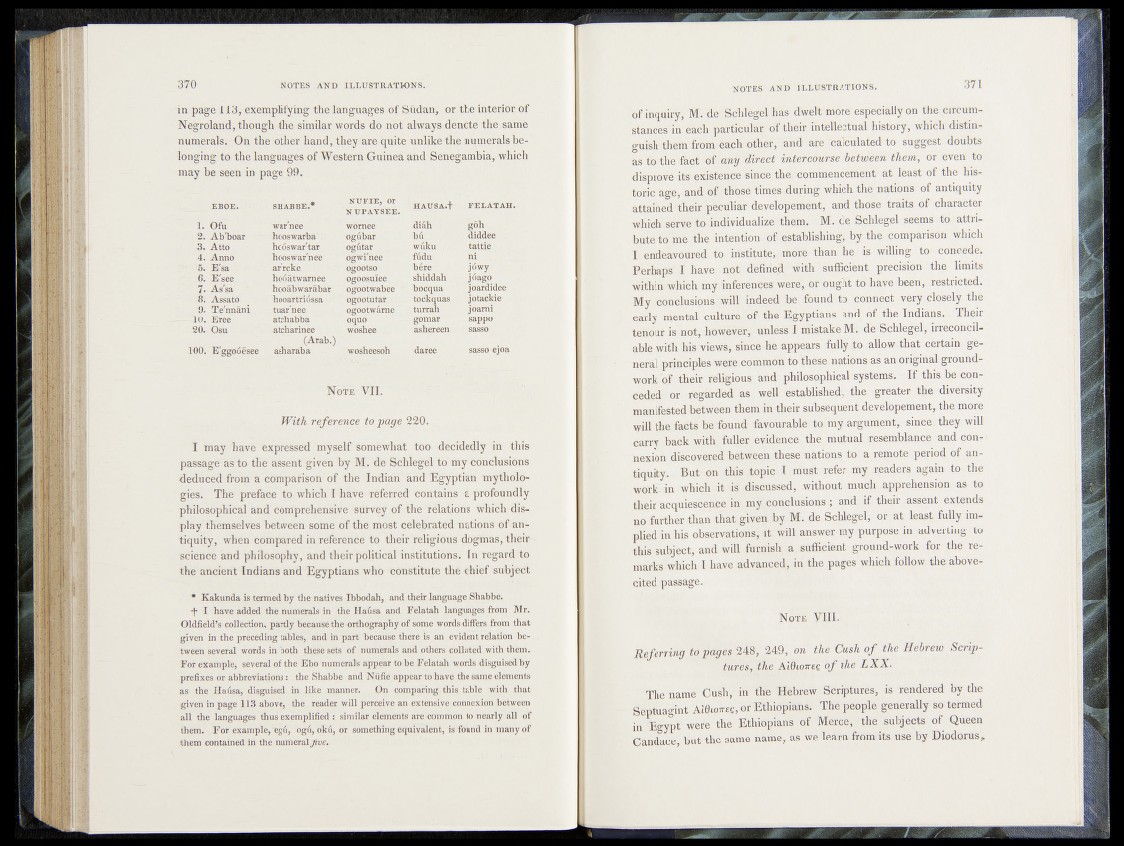
in page 113, exemplifying the languages of Shdan, or the interior of
Negrolaiid, though the similar words do not always denote the same
numerals. On the other hand, theyure quite unlike the numerals belonging
to the languages of Western Guinea and Senegambia, which
may be seen in page 99.
EBOE. SHABBE.*
i . Ofù war'nee
2 . AbTyoar hooswarba
3. Atto hoóswar'tar
4. Anno hooswar'nee
5. E'sa ar'rcke
6. E'see hoóatwarnee
7- As'sa hooâbwarâbâr
8 . Assato hooartrióssa
9. Te'nnâni tuar'nee
1 0 . Eree atchabba
2 0 . Osu atcharinee
(Arab/
1 0 0 . Eggoóêsee asharaba
NUFIE, or
N UPAYSÉE. HAUSA.t FELATAH,
womee diâh g ôh
ogubar j b<L diddee
ogutar wfiku tattie
ogwi'nee f i i i i n i ' j
ogootso bére- jówy
ogoosuïee. shiddah jóago
ogöotwabee boequa joardidee
ogootutar tockquas jotàckre
ogootwame turrah joami
oquo goxnar sappo
woshee ashereen sasso
wosheesoh daree sasso ejoa
N ote VII.
With reference to page 220.
I may have expressed myself somewhat too decidedly in this
passage as to the assent given by M. de Schlegel to my conclusions
■deduced from a comparison of the Indian and -Egyptian mythologies.
The preface to which I have- referred contains â profoundly
philosophical and comprehensive survey of the relations which display
themselves between some of the most celebrated nations of antiquity,
when compared in reference to their religious dôgïnas, their
science and philosophy, and their political institutions.1 In regard to
the ancient Indians and Egyptians who constitute the chief subject
* Kakunda is termed by the natives Ibbodah, and their language Shabbe.
-f- I have added the numerals in the Hatisa and Felatah languages from Mr.
Oldfield’s collection, partly because the orthography of some words differs from that
given nr the preceding tables, and in part because there is an evident relation between
several words in both these sets of numerals and others collated with them.
For example, several of the Ebo numerals appear to be Felatah words disguised by
prefixes or abbreviations: the Shabbe and Nijfie appear to have the same elements
as the Hafisa, disguised in like manner. On comparing this table with that
given in page 113 above, the reader will perceive an extensive connexion between
all the languages thus exemplified: similar elements are common to nearly all of
them. For example, egli, ogfi, ok6, or something equivalent, is found in many of
them contained in the numeral Jive.
of inquiry, M‘. de Schlegel has dwelt more especially on the circumstances
in each particular of their intellectual history, which distinguish
them from each other, and are calculated to suggest doubts
as to the fact of any direct intercourse between them, or even to
disprove its existence since the. commencement at least of the historic
age, and of those times daring which the nations of antiquity
attained their peculiar developement, and those traits of character
which serve to individualize them. M. de Schlegel seems to attribute
to me the intention.* of establishing, by the comparison which
I endeavoured to institute,, more than hq is willing to concede.
Perhaps I have not defined with sufficient precision the limits
within which my inferences' were, or ought to have been, restricted.
My conclusions will indeed be found to connect very closely the
early mental culture of the Egyptians and of the Indians. Their
tenour is not,,however, unless 1 mistake M. de Schlegel, irreconcilable
with his views, since he appears fully.jib allow that certain general
principles were common to these nations, as an original groundwork
of their religious and philosophical systems- • If this be conceded
or regarded as well established, the greater the diversity
manifested between them in their subsequent developemënt, the more
will the facts be found favourable to my argument, since they will
carry back with fuller evidence the mutual resemblance and eon-1
nexion discovered between these nations to a remote period of antiquity.
But on this topic I must refer my readers again to the
worE in which it is discussed, without much apprehension as to
their acquiescence in my conclusions ; and if their assent extends
no further than that given by M. de Schlegel, or at least fully implied
in his observations, it will answer my purpose in adverting , to
this subject, and Will furnish a sufficient ground-work for the remarks
which I have advanced, in the pages which follow the above-
cited passage.
Note YIII.
Referring to pages 248, 249, on the Cush o f the Hebrew Scriptures,
the Aldiowse o f the LXX.
The name Cush, in the Hebrew Scriptures, is rendered by the
- Septuagint Aifiiow«, or Ethiopians. The people generally so termed
in Egypt were the Ethiopians of Meroé, the subjects of Queen
Candace, but the same name, as we learn from its use by Diodorus,